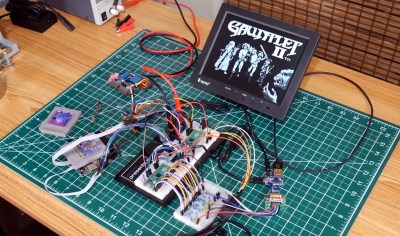For the Nintendo aficionados of the 90s, the Super Game Boy was a must-have cartridge for the Super Nintendo which allowed gamers to play Game Boy games on your TV. Not only did it allow four-color dot-matrix gaming on the big screen, but it let you play those favorite Game Boy titles without spending a fortune on AA batteries. While later handhelds like the PSP or even Nintendo Switch are able to output video directly to TVs without issue, the original Game Boy needed processing help from an SNES or, as [Andy West] shows us, it can also get that help from a modern microcontroller.

The extra processing power in this case comes from a Raspberry Pi Pico which is small enough to easily fit inside of a donor NES case and also powerful enough to handle the VGA directly. For video data input, the Pico is connected to the video pins on the Game Boy’s main board through a level shifter. The main board is also connected to a second Pico which handles the controller input from an NES controller. Some fancy conversion needed to be done at this point because although the controller layouts are very similar, they are handles by the respective consoles completely differently.
With all of the technical work largely out of the way, [Andy] was able to put the finishing touches on the build. These included making sure the power buttons, status LEDs, and reset button all functioned, and restoring the NES case complete with some custom “Game Guy” graphics to match the original design of the Game Boy. We commend the use of original Game Boy hardware in this build as well, which even made it possible for [Andy] and his wife to play a head-to-head game of Dr. Mario through a link cable with another Game Boy. If you’re looking for a simpler way of playing on original hardware without burning a hole in your wallet buying AA batteries, take a look at this Game Boy restoration which uses a Lithium battery instead.
Thanks to [BaldPower] and [adistuder] from the Hackaday Discord server for sending this one in.
















Interesting build just three comments:
– Spending a fortune in AAs?? Come on, GB was able to run for hooooours on 4 AAs, not enough motivation for this build. Playing the games on TV definitely is.
– The PI is not small enough to fit inside a NES case, nope… you can put tons of PIs inside a donor NES case indeed hahahaha
– One PI for NES controller decoding is overkill, but I guess that is what he had around, more than reasonable justification.
It is a pity it is just emulation, similar build with a FPGA would be awesome, or even using the original GB hardware and video output via GBHDMI or GBVGA projects.
You picked apart the article yet failed to notice that this is using the original motherboard NOT emulation?
It’s not emulation? It’s hooking into the video signals and input signals of a real GB board.
Fast answering before watching the video leaving from work… You are right, it’s using the boards for decoding and not emulation. My bad!
He used a pair of Pi Picos, which are very small and thin.
Pretty cool!
Would be awesome to see this taken to the next level, built into the body of a nes mini and capable of reading gameboy cartridges ^^
I do kind of agree with 3L_S4N70 that using a pico just for the controller is a bit much, plus i also cant help but point out this is not quite on par with Ben’s console related projects, Element14 suffered from him leaving imho. But hey, still a cool project overall :)
but its not emulation. its a pi pico converting gb lcd signals to vga, and then another pico doing controller conversion
this was a reply to a comment above mentioning its a pity its just emulation. im certain i hit the reply button
I believe this
Some fancy conversion needed to be done at this point because although the controller layouts are very similar, they are handles by the respective consoles completely differently.
should be
*handled by* not handles
Lol you can probably just use one cpld instead of 2 micros
Aww … for a short second I thought he would interface an actual Super Game Boy to work without an attached SNES. Still really nifty, tho, if entirely unpractical nowadays.
A better use of two Raspberries would be for some sort of rude Belgian automaton. You could call it the
“Mannequin Pis”
I would love to have two tv-gb with the link system. Like the super game boy 2 that nobody can have
But let’s be honest … Emulation don’t do any difference here, it’s moving gray squares or green-yelllow squares that we want to see.
Give me a link system based on the gpio of an rpi and I take out my four versions of WaveRacer !